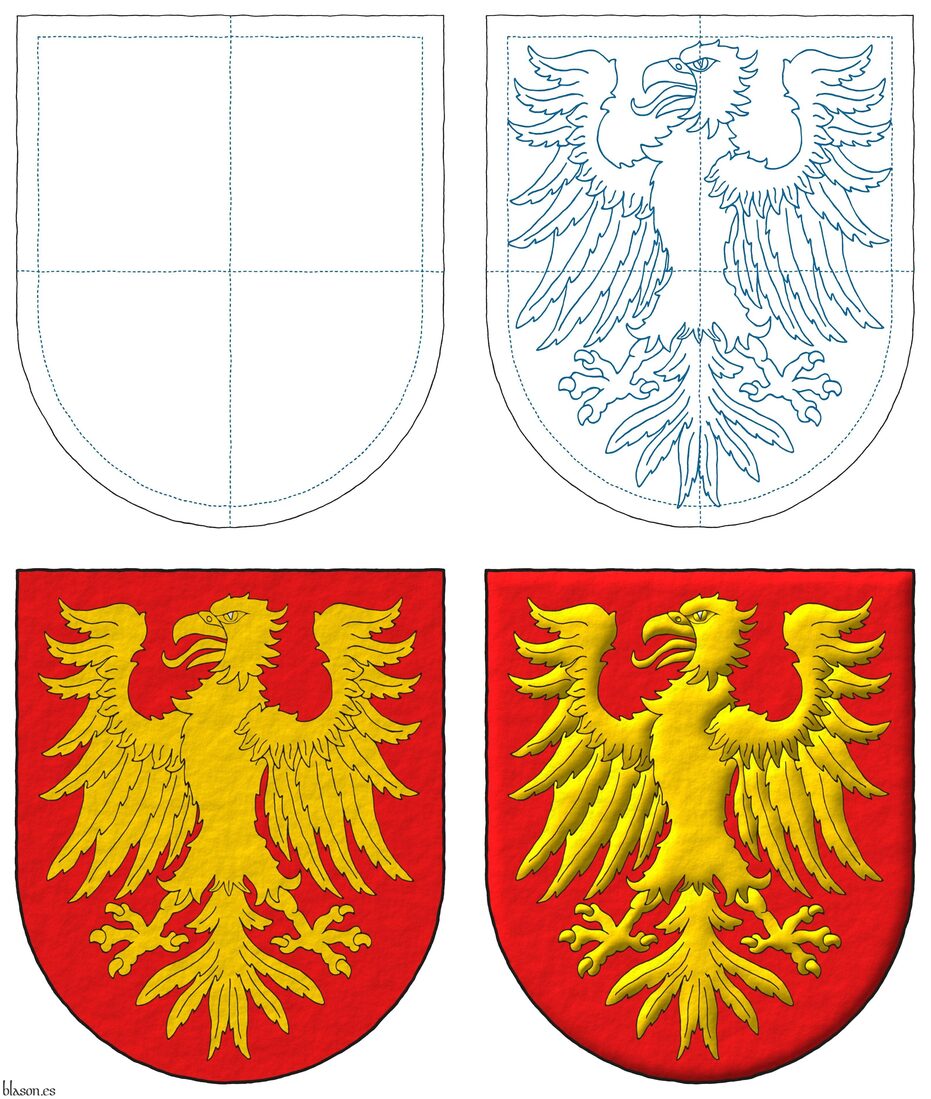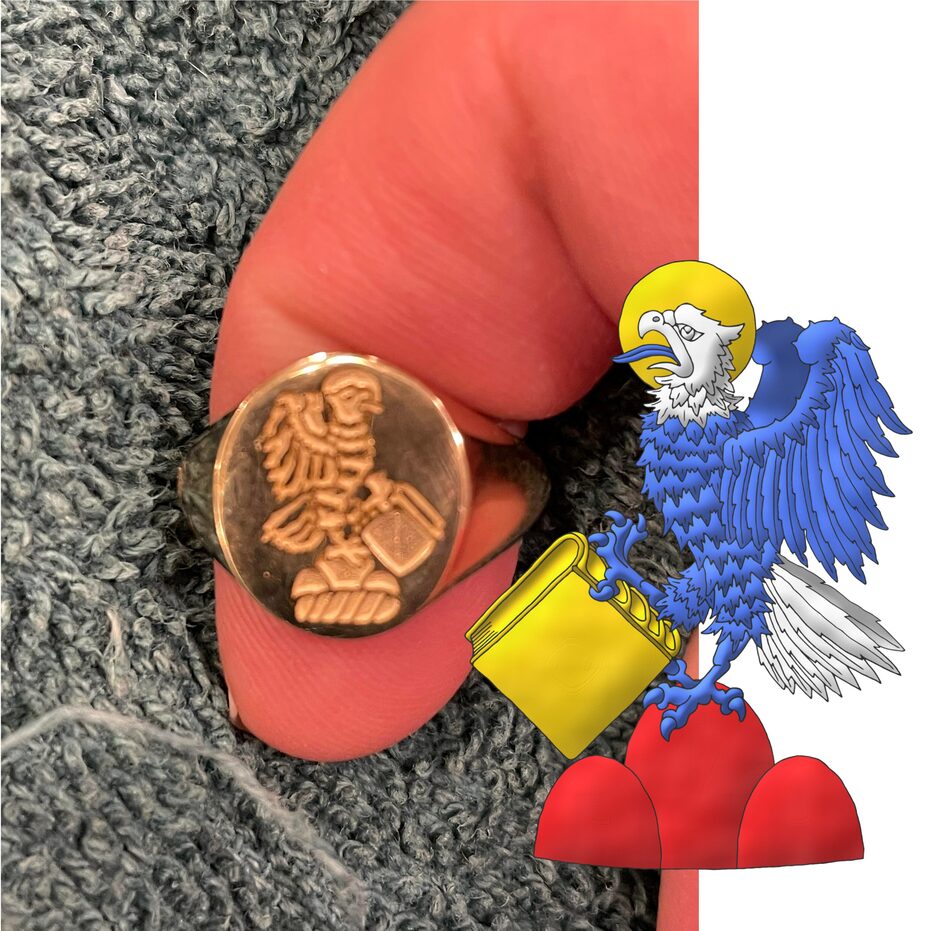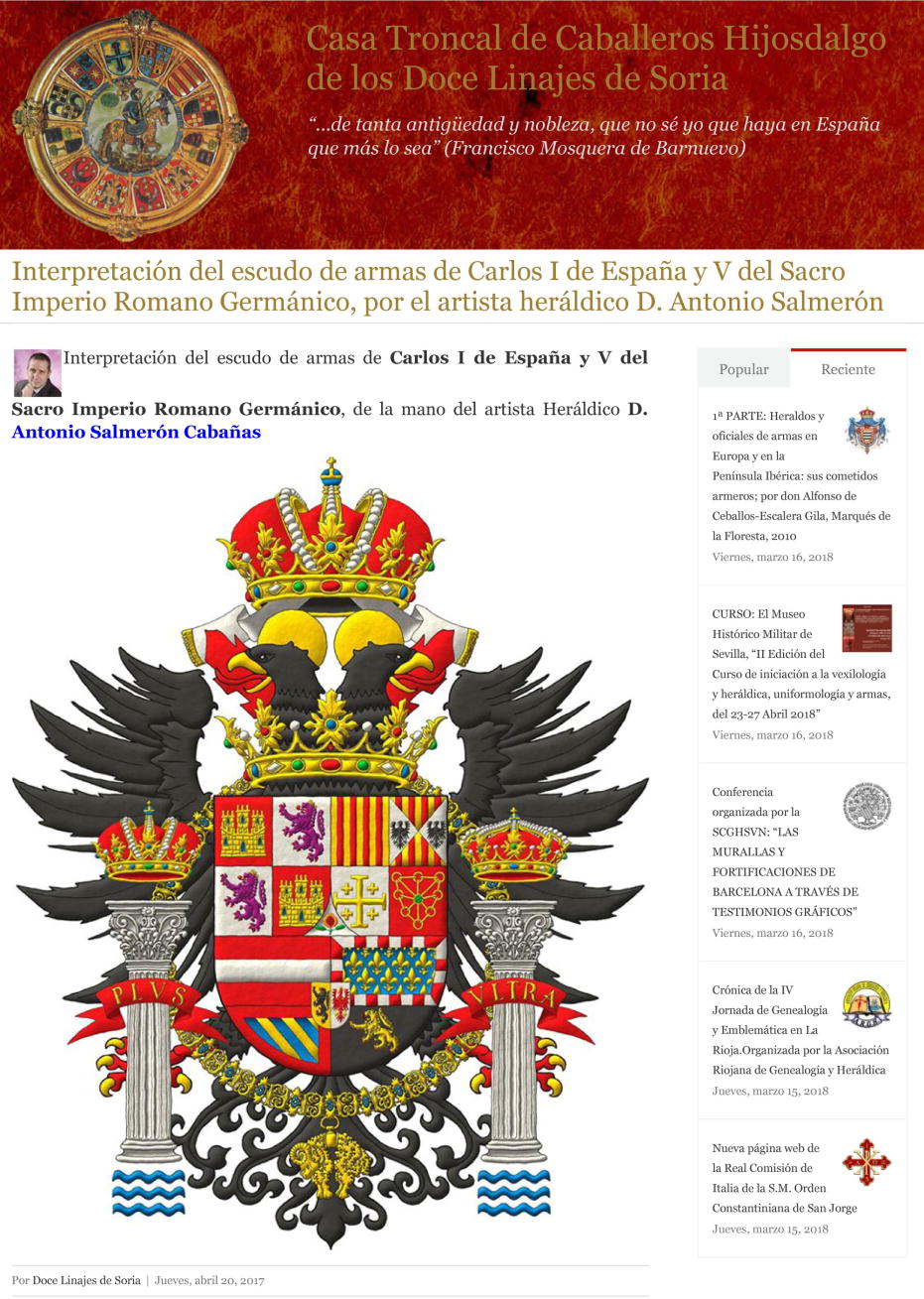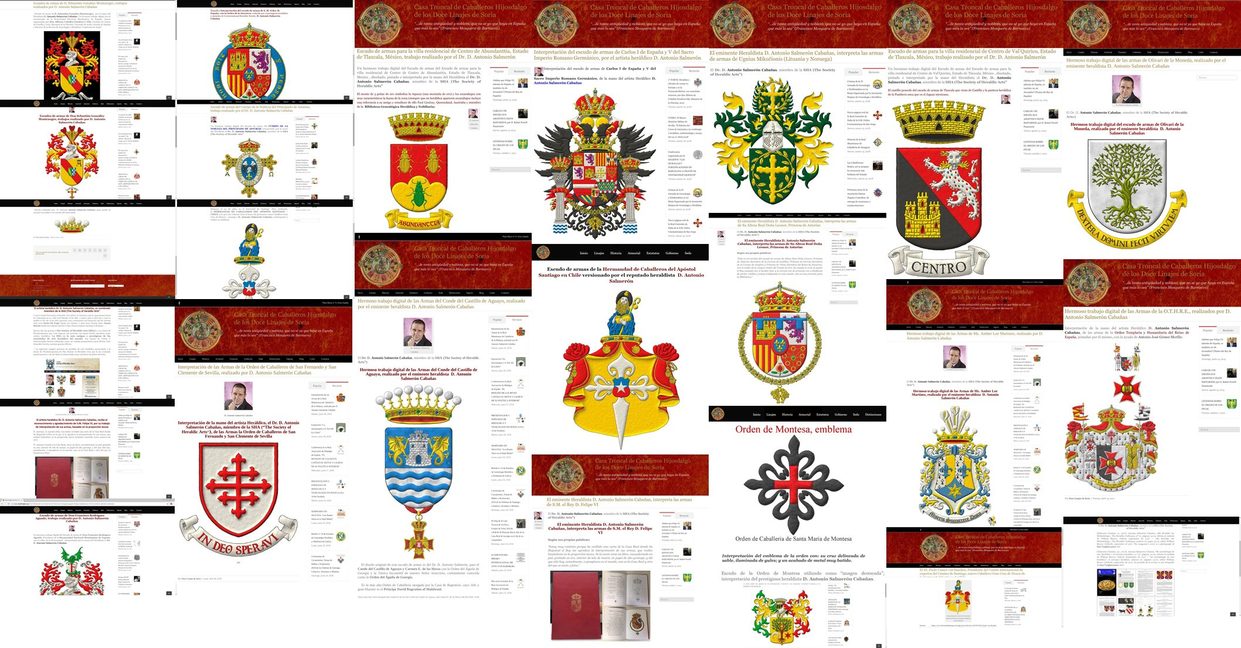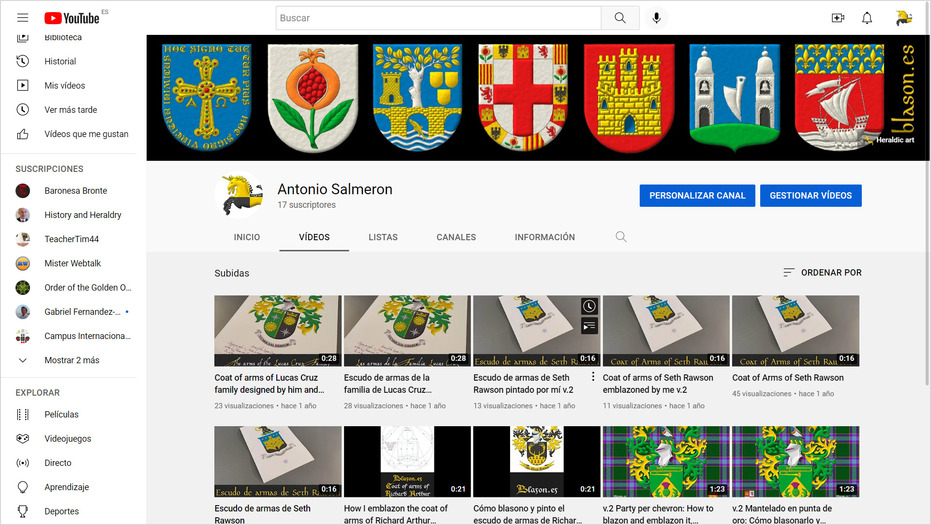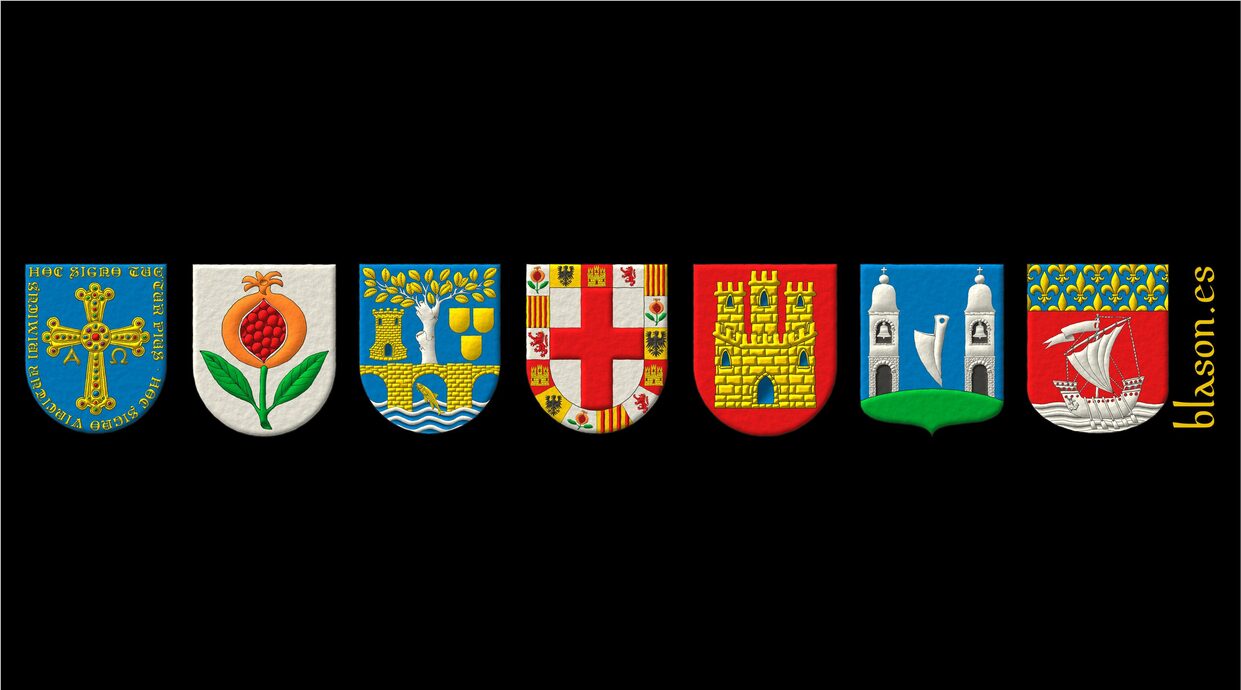Eagle


Aras Quirce, Manuel Maria
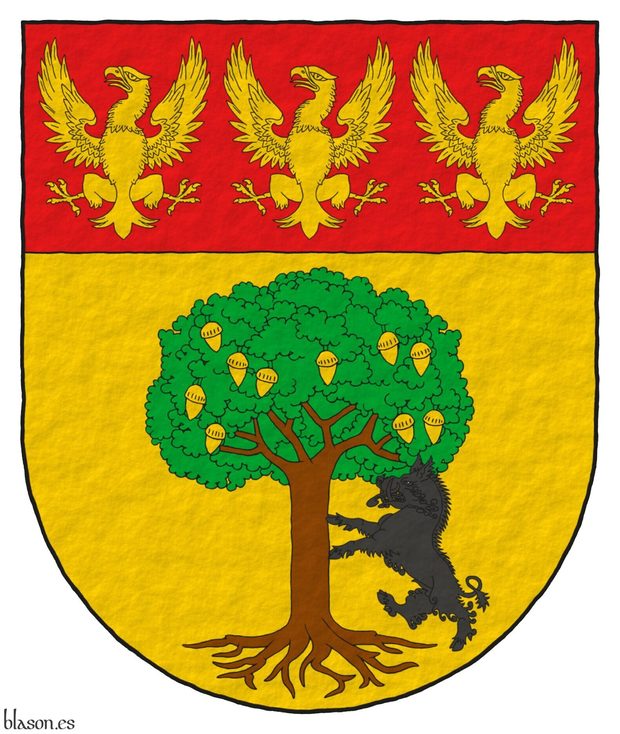
Or, an oak tree proper, fructed Or, with a boar supporting it Sable; on a chief Gules, three eagles displayed Or.
Escudo de oro, un roble al natural, frutado de oro, con un jabalí empinado de sable; en un jefe de gules, tres águilas de oro.
Escudo interpretado por mí, en tinturas planas, delineado de sable, con un contorno exterior medio punto y con un terminado texturizado.
Coat of arms of Manuel Maria Aras Quirce designed by Juan Lanzagorta Vallin and emblazoned by me.
Credits: Juan Lanzagorta Vallin is the designer of the coat of arms.
Blazon keywords: Or, One, Oak, Tree, Proper, Fructed, Boar, Supporting, Sable, Chief, Gules, Three and Eagle.
Style keywords: Outlined in sable, Plain tincture and Semi-circular.
Classification: Personal, Interpreted and Coat of arms.
Bearer: Aras Quirce, Manuel Maria.


Arrano Beltza
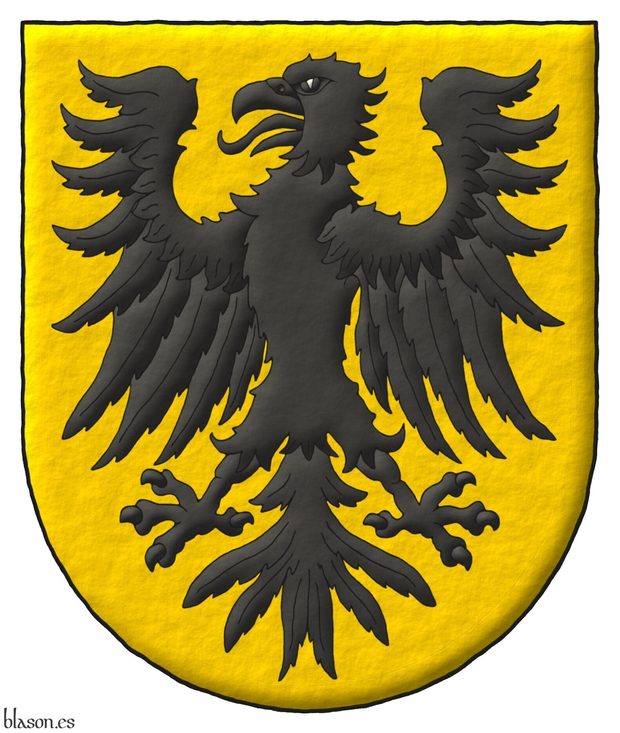
Or, a eagle displayed Sable.
Escudo de oro, un águila de sable.
Arms painted by me, illuminated with lights and shadows, contoured in Sable, and with a freehand finish.
Coat of arms of the Arrano Beltza, the black eagle in Basque, emblazoned by me.
Blazon keywords: Or, Sable, One, Eagle and Displayed.
Style keywords: Outlined in sable, Illuminated and Freehand.
Classification: Civic, Interpreted, Boa and Coat of arms.
Bearer: Arrano Beltza.


Beatrice of Swabia

Or, an eagle displayed Sable.
Escudo de oro, un águila de sable.
Coat of arms painted by me, highlighted with lights and shadows, outlined in Sable, with an ogee external shape and with a freehand finishing.
Coat of arms of the Queen Beatrice of Swabia, 1205–1235, baptized as Elisabeth, wife of King Ferdinand III of Castile, 1199–1252. The eagle Sable on an Or field is a distinctive symbol of the Holy Roman Empire. This coat of arms has been emblazoned by me.
Blazon keywords: Or, Sable, One and Eagle.
Style keywords: Outlined in sable, Illuminated, Ogee and Freehand.
Classification: Personal, Interpreted, Boa and Coat of arms.
Bearer: Beatrice of Swabia.


City of Almeria, structured and parallel blazons
Coat of arms of the city of Almeria, Andalusia, emblazoned by me, with the blazon written in English and Castilian in a structured way to observe the parallelism between both forms. Starting from the section at the dexter chief as number 1, I number the sections of the bordure clockwise. In this particular case, as in others where the number of different charges is an exact divisor of the total number of sections, the numbering coincides even if counted counterclockwise.
Blazon keywords: Argent, Gules, Or, Sable, Vert, One, Four, Fifteen, Cross, Bordure, Compony, Pomegranate, Slipped, Leaved, Proper, Eagle, Castle, Triple-towered, Port and windows, Masoned, Lion, Rampant, Crowned, Pallet, Closed royal crown, Crown, Motto and Scroll.
Style keywords: Outlined in sable, Illuminated, Semi-circular and Parchment.
Classification: Civic, Interpreted, Structured and parallel blazons, Boa and Coat of arms.
Bearer: Almeria, city of.


Crest and motto of Reynaldo Romero
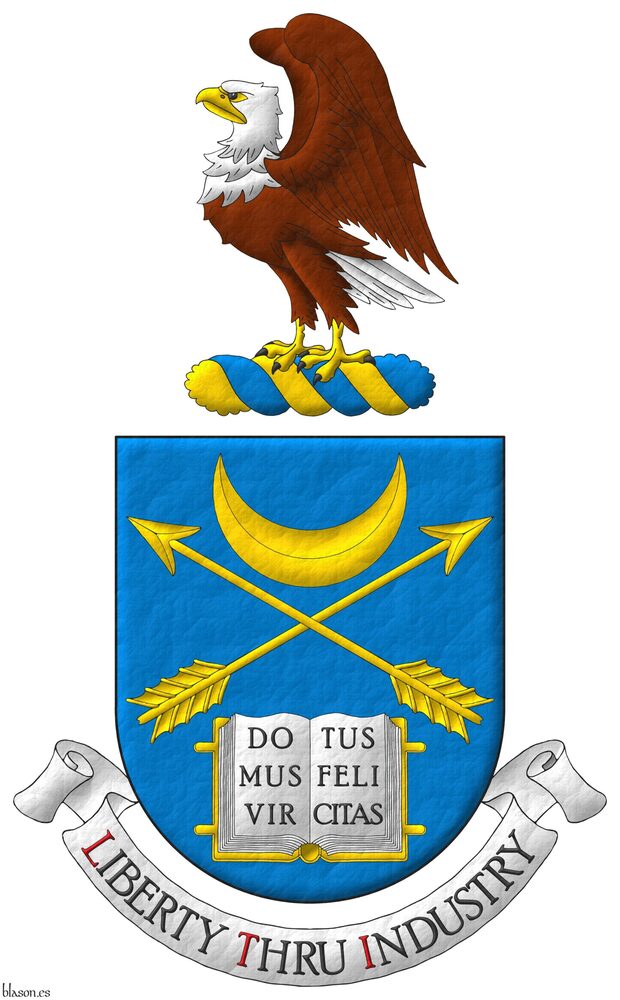
Azure, two arrows points upwards in saltire between, in chief a crescent Or, in base an open book Argent, garnished Or, the pages inscribed «Domus Virtus Felicitas» Sable. Crest: Upon a wreath Or and Azure, a bald eagle rising, wings addorsed and inverted proper. Motto: «Liberty Thru Industry».
Coat of arms painted by me, highlighted with lights and shadows, contoured in Sable, with a semi-circular external shape and with a leather finishing.
Blazon keywords: Azure, Or, Argent, Sable, One, Two, Arrow, Point upwards, In saltire, Between, In chief, Crescent, In base, Open book, Book, Page, Inscribed, Crest, Upon (wreath), Wreath, Bald eagle, Eagle, Rising, Wing, Addorsed, Proper and Motto.
Style keywords: Outlined in sable, Illuminated, Semi-circular and Leather.
Classification: Personal, Interpreted, Boa and Coat of arms.
Bearer: Romero, Reynaldo.


Crest of Javier Francisco Javier Lasuncion Patus
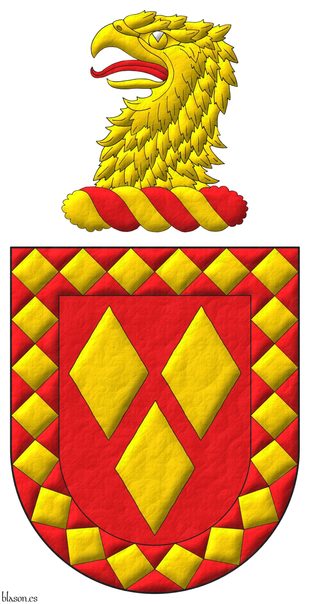
Gules, three lozenges Or; a bordure lozengy Gules and Or. Crest: Upon a wreath Or and Gules, an eagle’s head erased Or, langued Gules.
Arms devised by me, highlighted with lights and shadows, outlined in Sable, with a semi-circular external shape and with a leather finishing.
Blazon keywords: Gules, Or, One, Three, Lozenge, Lozengy, Bordure, Crest, Upon (wreath), Wreath, Eagle, Head, Erased and Langued.
Style keywords: Outlined in sable, Illuminated, Semi-circular and Leather.
Classification: Personal, Created, Boa and Coat of arms.
Bearer: Lasuncion Patus, Francisco Javier.


Crest of Kelly Kathleen Knox
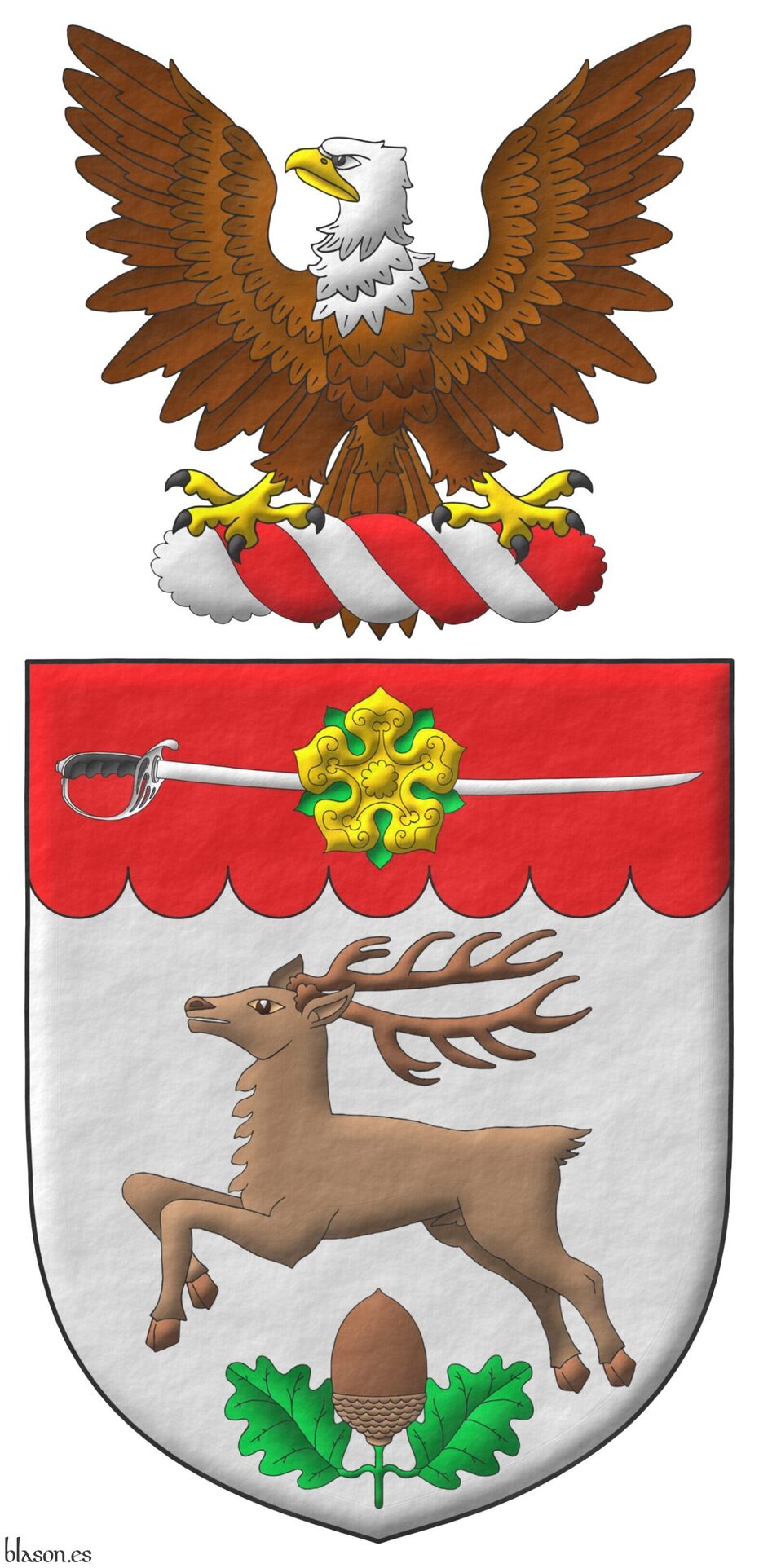
Argent, a stag springing, in base an acorn leaved and slipped proper, on a chief invected Gules, a sabre fesswise, point sinister proper, debruised by a rose Or, leaved Vert. Crest: Upon a wreath Argent and Gules, a bald eagle displayed proper.
Coat of arms designed by me, highlighted with lights and shadows, contoured in Sable, with a pointed outer contour and with a rough finishing.
Blazon keywords: Argent, Gules, Or, Vert, One, Stag, Springing, In base, Acorn, Leaved, Slipped, Proper, Chief, Invected, Sabre, Sword, Fesswise, Facing sinister, Debruised, Rose, Crest, Upon (wreath), Wreath, Bald eagle, Eagle and Displayed.
Style keywords: Outlined in sable, Illuminated, Pointed and Rough.
Classification: Personal, Created, Boa and Coat of arms.
Bearer: Knox, Kelly Kathleen.


Crest of Robert Sales
Azure, a carbuncle of twelve rays Argent; on a chief Or, a hop cone Vert between two apples Gules, slipped and leaved Vert. Crest: Upon a helm, with a wreath Argent and Azure, an eagle displayed Or, langued Gules, holding in his dexter talon an hourglass bendwise proper. Mantling: Azure doubled Argent.
Blazon keywords: Azure, Carbuncle, Twelve, Argent, Chief, Or, Hop cone, Flower, Vert, Between, Two, Apple, Gules, Slipped, Leaved, Crest and mantling, Helm, Mantling, Wreath, Crest, Eagle, Langued, Grasping, Hourglass, Bendwise and Proper.
Style keywords: Outlined in sable, Illuminated, Pointed and Freehand.
Classification: Personal, Created and Coat of arms.
Bearer: Sales, Robert Edward.


Crest, mantling and motto Vitéz László Gábor
Per fess, the base per pale: 1 Or, an eagle displayed Sable; 2 Gules, a sun in splendour Or; 3 Or, an increscent Gules; all within a bordure Sable, charged with eight fleurs de lis Or. Crest: Upon helm affronty Argent, fimbriated and barred Or, lined Gules, with a wreath Or and Sable, a crown of Duke. Mantling: Sable doubled Or. Motto: «Virtus Nobilitatis Fidelitas» Sable, with initial letters Gules over a scroll Argent.
Coat of arms depicted by me, highlighted with lights and shadows, contoured in Sable, with a pointed outer contour and with a leather finishing.
This is his coat of arms Vitéz László Gábor emblazoned by me. Per fess is the horizontal division into two parts, and per pale is the vertical division into two; therefore, per fess and per pale in base means that the shield is first divided horizontally, with the upper part as the first quarter, and the lower part is then divided vertically into two, forming the second and third quarters. The heraldic crescent is a moon with its horns pointing upward (to chief); to distinguish it from the natural crescent moon, in Spanish heraldry it is called «creciente tornado», while in English the equivalent term is increscent. The Castilian «filiera» is a narrow bordure, thinner than the ordinary one; in English it has no specific name and is usually referred to simply as a bordure, or rarely as a diminished bordure or fillet bordure. In the crest, fimbriated and barred Or indicates that the border details and grill-bars of the helm are gold, while lined refers to its interior, here Gules.
Blazon keywords: Or, Sable, Gules, Argent, One, Eight, Party per fess, the base per pale, Eagle, Displayed, Sun in splendour, Increscent, Bordure, Fleur de lis, Crest, Helm, Affronty, Barred, Lined, Wreath, Crown, Mantling, Doubled, Motto and Scroll.
Style keywords: Outlined in sable, Illuminated, Pointed and Leather.
Classification: Personal, Interpreted, Boa and Coat of arms.
Bearer: László Gábor.


Crown of the Infanta Berenguela of Castile

Quarterly: 1 and 4 Gules, a castle triple-towered Or, port and windows Azure, and masoned Sable; 2 and 3 Argent, a lion rampant Purpure, armed and langued Gules; a bordure compony of sixteen sections: eight Gules, a castle triple-towered Or, port and windows Azure, and masoned Sable, eight Or, an eagle displayed Sable. Crest: An open royal crown.
Arms emblazoned by me, illuminated with lights and shadows, contoured in Sable, with an ogee external shape and with a metal beaten finish.
Coat of arms of the Infanta Berenguela of Castile, 1228–1279, 5th daughter of the King Ferdinand III of Castile, 1199-1252, and the Queen Beatrice of Swabia, 1205–1235. The coat of arms of Infanta Berenguela of Castile, besides being beautiful, has always seemed to me the epitome of the Castilian arms: quartered, bearing Leon and Castile, and surrounded by a bordure compony with castles. This coat of arms has been emblazoned by me.
Blazon keywords: Gules, Or, Azure, Sable, Argent, Purpure, One, Sixteen, Eight, Quarterly, Castle, Triple-towered, Port and windows, Masoned, Lion, Rampant, Armed, Langued, Bordure, Compony, Eagle, Crest, Open royal crown and Crown.
Style keywords: Outlined in sable, Illuminated, Ogee and Metal beaten.
Classification: Personal, Kingdom of Castile and Leon, Interpreted, Boa and Coat of arms.
Bearer: Berenguela of Castile, Infanta.


Edmund Leighton, 1901, The Accolade

I swear by the 1st rule of heraldry I will never emblazon again an eagle Sable on a field Gules.
The heraldic rule of tinctures: «a colour cannot go on top of another colour and a metal cannot go on top of another metal».
This coat of arms is similar to the arms of Henry VI the Good, Prince of Silesia and Duque of Wroclaw, blazon: «Gules, an eagel displayed Sable».
If it was Edmund Leighton's intention to paint Henry VI, then the justification would be that Silesia is located in Poland and in the Polish heraldic tradition, the sable is considered a neutral tincture, that is neither color nor metal, so they can put the sable on the color gules. But I doubt that the Prince of Silesia and Duke of Wroclaw would have needed to be knighted.
Categories: Technology, Social networks, Colour on colour, Eagle, Sable and Gules.


Facebook, Members and Friends of the Order of the Eagle of Georgia
Cover image of the Facebook group «Members and Friends of the Order of the Eagle of Georgia» based on my interpretation of the badge of the Order of the Eagle of Georgia and the Seamless Tunic of Our Lord Jesus Christ.
Categories: Technology, Social networks and Eagle.
Root: Facebook.


Full achievement of Michael Twist
Party per fess Argent and Or, in chief twenty one fleurs de lis Sable, 8, 7, and 6, in base, a stag passant Gules attired proper, holding in its mouth a sprig Vert, gorged with a wreath Argent and Or. Crest: Upon a helm befitting his degree, with a wreath Or and Gules, an eagle displayed facing sinister Gules. Mantling: Gules doubled Or. Motto: «Souviens Toi De Vivre».
Coat of arms interpreted by me, highlighted with lights and shadows, outlined in Sable, with a pointed outer contour and with a freehand finish.
G0130, Chief Herald of Arms of Malta's grant for the arms of Michael Twist, Malta. These arms have been emblazoned by me for such grant.
Blazon keywords: Argent, Sable, Or, Gules, Vert, Twenty one, One, Party per fess, In chief, Fleur de lis, Stag, Passant, Attired, Grasping, Sprig, Gorged, Wreath, Crest, Upon (wreath), Helm, Eagle, Facing sinister, Mantling, Doubled and Motto.
Style keywords: Outlined in sable, Illuminated, Pointed and Freehand.
Classification: Personal, Interpreted, Boa and Coat of arms.
Bearer: Twist, Michael.


Germany, Federal Republic of

Or, a eagle displayed Sable, beaked, langued, armed and membered Gules.
Escudo de oro, un águila de sable, picada, lampasada, armada y membrada de gules.
Coat of arms painted by me, highlighted with lights and shadows, outlined in Sable, and with a freehand finish.
Coat of arms for the Federal Republic of Germany emblazoned by me.
Blazon keywords: Or, Sable, Gules, One, Eagle, Displayed, Beaked, Langued, Armed and Membered.
Style keywords: Outlined in sable, Illuminated and Freehand.
Classification: Civic, Interpreted, Boa and Coat of arms.
Bearer: Germany, Federal Republic of.


Infante Manuel of Castile, schema 3x4
In Castile, a coat of arms quarterly does not necessarily signify inheritance. This schema illustrates two practices: a) Quarterings can represent the mother in the 1st and 4th quarters and the father in the 2nd and 3rd, highlighting the prominence given to the maternal line by placing it in the most visible quarters. b) Quarterings can also include personal symbols and concepts, like canting arms, for example, «Manuel» =«mano» + «ala» = «hand» + «wing», combined with ancestral arms. This flexibility reflects Castilian heraldic traditions, where arms are not strictly marshalled by inheritance. The inclusion of maternal arms in the 1st and 4th quarters highlights how Castilian heraldry often elevates maternal heritage, differing from some other heraldic traditions. The previous commentary emphasizes the creative freedom in Castile, where quartering could incorporate personal symbols or canting arms without the constraints of inheritance or dominium. This flexibility aligns with Castilian culture, allowing heraldry to reflect personal identity, not just dynastic ties. Notably, the arms of Infante Enrique's use of a cross flory demonstrates this creative freedom, showcasing the ability to innovate within heraldry even in royal contexts. While this might seem unconventional compared to other heraldic systems, it is deeply rooted in Castilian tradition. All coats of arms in this schema have been emblazoned by me.
Blazon keywords: Argent, Purpure, Gules, Or, Azure, Sable, One, Quarterly, Lion, Rampant, Armed, Langued, Castle, Triple-towered, Port and windows, Masoned, Bordure, Compony, Eagle, Cross flory, Cross couped, Party per pale, Hand, Arm, Vambraced, Embowed, Winged, Sword, Point upwards and Hilted.
Style keywords: Outlined in sable, Illuminated and Ogee.
Classification: Personal, Kingdom of Castile and Leon, Interpreted, Design rationale, Schema, Boa and Coat of arms.
Bearer: Manuel of Castile, Infante.


Juan Lanzagorta Aras accolé with María Dolores Escutia Sánchez
[ Party per pale bendy wavy Azure and Or and bendy wavy Azure and Argent, overall three fish naiant in pale Argent ] accolé with [ Or, an eagle displayed bendy Azure and Argent ].
Arms depicted by me, in plain tinctures, contoured in Sable, and with a texturized finish.
These are the coats of arms of the marriage Lanzagorta-Escutia, both designed by Juan Lanzagorta Vallín and emblazoned by me. This image shows the arms of Juan Lanzagorta Aras accolé with those of María Dolores Escutia Sánchez.
Blazon keywords: Azure, Or, Argent, Three, One, Party per pale, Bendy, Wavy, Overall, Fish, Naiant, In pale, Eagle and Displayed.
Style keywords: Outlined in sable and Plain tincture.
Classification: Personal, Interpreted, Boa, Coat of arms and Accolé arms.
Bearer: Lanzagorta-Escutia, marriage.


Lineage Baldovino from Venecia, schema 2x2
Gules, an eagle displayed Or.
Coat of arms of the lineage Baldovino from Venecia, emblazoned by me in 4 steps: guideline drawing, outlined, plain color and metal, and lights and shadows. From Jean-Baptiste Rietstap, «Armorial général», 1st edition, 1861, [Rietstap, J. B.; 1861; P1 CXII B, row 7, column 7].
Blazon keywords: Gules, Or, One, Eagle and Displayed.
Style keywords: Outlined, Outlined in sable, Plain tincture, Illuminated and Semi-circular.
Classification: Personal, Lineage, Interpreted, Schema, Boa and Coat of arms.
Bearer: Baldovino from Venecia, lineage.


María Dolores Escutia Sánchez, plain tincture

Or, an eagle displayed bendy Azure and Argent.
Coat of arms emblazoned by me, in plain tinctures, contoured in Sable, with a semi-circular external shape and with a texturized finish.
Coat of arms of María Dolores Escutia Sánchez designed by Juan Lanzagorta Vallín and emblazoned by me. In the case of a bendy field like that of this eagle, it is not immediately clear whether it should be blazoned as bendy Azure and Argent, or rather as bendy Argent and Azure. I have followed the criterion of starting to list the tinctures from the dexter chief, that is, from the upper part of the eagle’s dexter wing, and therefore I blazon it as bendy Azure and Argent.
Blazon keywords: Or, Azure, Argent, One, Eagle, Displayed and Bendy.
Style keywords: Outlined in sable, Plain tincture and Semi-circular.
Classification: Personal, Interpreted, Boa and Coat of arms.
Bearer: Escutia Sánchez, María Dolores.


![Ver [Menéndez Pidal de Navascués, F.; 1974] en referencias bibliográficas. Libro abierto, hojas de plata, filo de oro, guardas de gules, tapas de sable.](../css/Libro.Bibliografia.png)
Menéndez Pidal de Navascués, F.; 1974
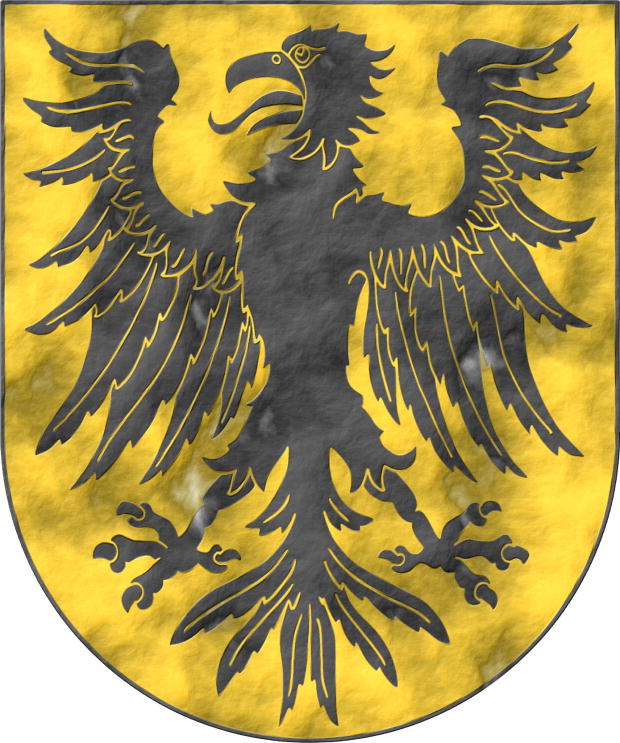
Faustino Menéndez Pidal de Navascués, «Book of Armory of the Kingdom of Navarra: Transcription and Study», published by La Gran Enciclopedia Vasca, 160 pages, ISBN 84-248-0119-9, Bilbao, 1974.
Transcription and study of the Navarrese manuscript armorial [Bosque, J. del; 1540], preserved in the General Archive of Navarra.
This book contains an introduction, the transcription of the armorial texts, its photographic reproduction, which also includes the Navarrese coats of arms of the Reyneck armorial and the coat of arms of the refectory of the Cathedral of Santa María la Real de Pamplona, an index of names, a heraldic table, and a set of appendices [Martínez de Aguirre, J.; 2007; page 351].
The coat of arms accompanying this bibliographic reference is that of Qasqante de Navarra following, precisely, the armorial of Juan del Bosque.
Bibliographical reference of century XX.
The author is Menéndez Pidal de Navascués, Faustino.
The following articles cite this bibliographic reference:
- Bosque, J. del; 1540
- Martinena Ruiz, J. J.; Menéndez Pidal de Navascués, F.; 2001
- Navarra, closed carbuncle
External resources:


Noblemen of Navarre

The King of Navarre, at the time of his new and solemn coronation, is raised and lifted up as King by the hands of twelve barons of the greatest and oldest houses of the said Kingdom, and these are the twelve Noblemen who are named on the other side, with their blazons and coats of arms.
Interpretation and composition of 13 coats of arms that I have created with a parchment-like finish.
A free interpretation, for example, without the central crown over the arms of Navarre, with a different title, written «Navarra» and not «Nabarra», etc., based on the principal plate of [Bosque, J. del; 1540; folio 1 of the numbering of 1613] and with texts taken from the transcription by [Martinena Ruiz, J. J.; 1982; pages 122 and 123].
«Ricohombre», written together, currently means «title that formerly belonged to the highest nobility of Spain», [Real Academia Española; 2001].
Its plural «ricoshombres» is the most commonly used form, but «ricohombres» is also correct and used; and in [Bosque, J. del; 1540] it is written separately, and «honbre» with an «n» before the «b», that is, «ricos honbres».
Blazon keywords: Without divisions, Party per bend, Azure, Gules, Or, Argent, Sable, Vert, Eagle, Chequey, Cross flory, Cross couped, Fess, Chief, Lion, Pale, Poplar leaf, Clay pot and Rampant.
Style keywords: Semi-circular and Old parchment.
Classification: Interpreted and Kingdom of Navarre.
Bearer: Noblemen of Navarre.


Peter Ferdinand Gummersbach, page of armorial
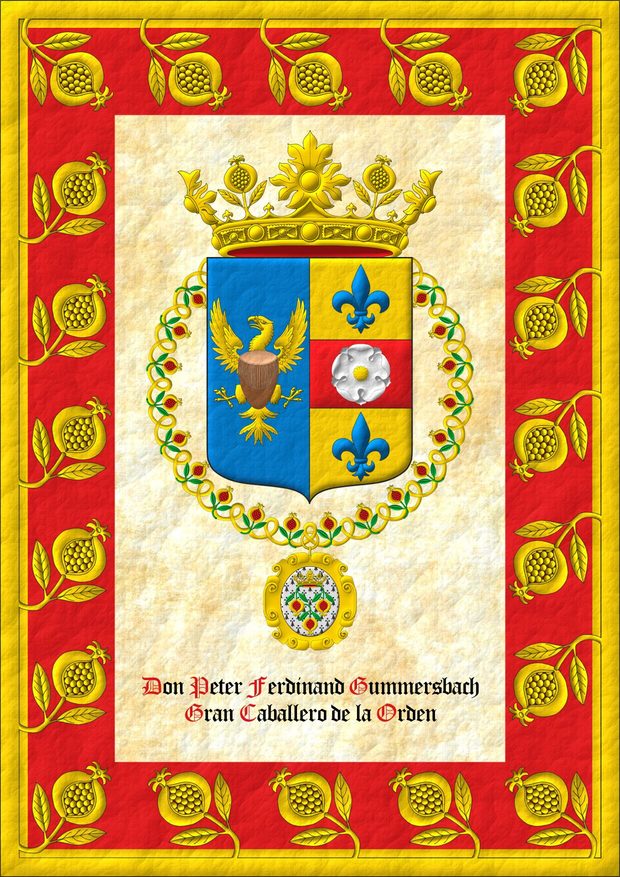
Party per pale: 1 Azure, an eagle displayed Or, charged on the chest with a Royal drum of Bunyoro-Kitara Kingdom proper; 2 Or, on a fess Gules between two fleur de lis Azure, a rose Argent, seeded Or. Crest: A crown of the Sovereign and Most Noble Order of the Pomegranate. The shield is surrounded by the Grand Collar of the Sovereign and Most Noble Order of the Pomegranate.
This is his coat of arms of emblazoned by me for the Roll of Arms of the Sovereign and Most Noble Order of the Pomegranate.
Blazon keywords: Party per pale, Azure, One, Eagle, Or, Charged, Chest, Drum, Royal, Proper, Fess, Gules, Rose, Argent, Seeded, Between, Two, Fleur de lis, In chief, In base, Crest and mantling, Crown, Pomegranate, Surrounded and Grand collar.
Style keywords: Ogee, Outlined in sable, Illuminated and Leather.
Classification: Personal, Interpreted, Coat of arms, Armorial roll and Castilian language.
Bearer: Gummersbach, Peter Ferdinand.


Philip of Castile, Infante
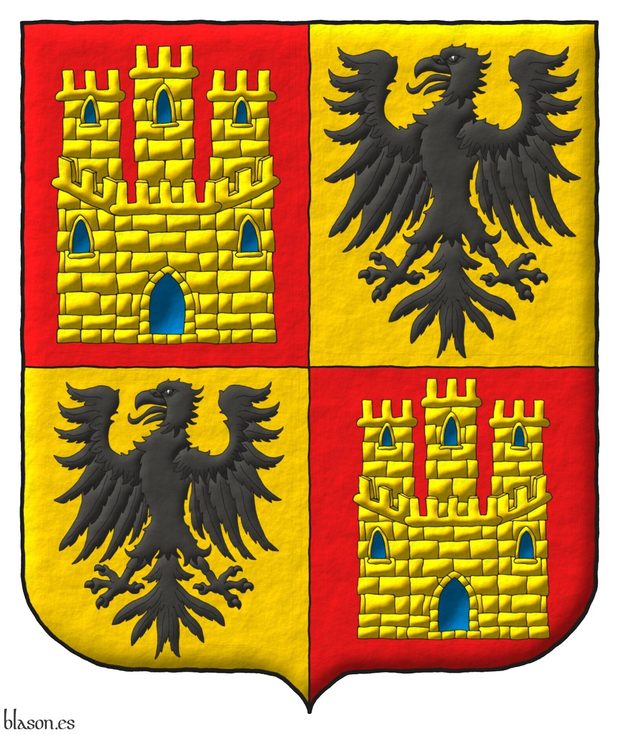
Quarterly: 1 and 4 Gules, a castle triple-towered Or, port and windows Azure, and masoned Sable; 2 and 3 Or, an eagle displayed Sable.
Escudo cuartelado: 1o y 4o de gules, un castillo de oro, aclarado de azur, mazonado de sable; 2o y 3o de oro, un águila de sable.
Arms painted by me, illuminated with lights and shadows, outlined in Sable, with an ogee external shape and with a freehand finish.
Coat of arms of the Infante Philip of Castile, 1231–1274, 7th offspring of the King Ferdinand III of Castile, 1199-1252, and the Queen Beatrice of Swabia, 1205–1235. This coat of arms has been emblazoned by me and can be consulted in [Messía de la Cerda y Pita, L.; 1990; page 146] with the field Or in the 2nd and 3rd quarters. He bears a quarterly shield combining the first quarter of his father’s arms, Castile, with his mother’s arms. Among all his siblings, he is the one who most closely combines the arms of both parents.
Blazon keywords: Gules, Or, Azure, Sable, One, Quarterly, Castle, Triple-towered, Port and windows, Masoned and Eagle.
Style keywords: Outlined in sable, Illuminated, Ogee and Freehand.
Classification: Personal, Kingdom of Castile and Leon, Interpreted, Boa and Coat of arms.
Bearer: Philip of Castile, Infante.


Qasqante of Navarre

Of the twelve lineages of Noblemen, the tenth is that of Qasqante; they bear as arms a shield Or and, on the shield, an eagle Sable, which is black, as it is now painted.
Or, an Eagle displayed Sable.
Escudo de oro, un águila de sable.
Coat of arms interpreted with: a semicircular (round) base; the field in flat Or; the eagle outlined in the colour of the field and illuminated in Sable; and finished in highly-hammered metal.
Based on the tenth coat of arms of the Navarrese «ricoshombres» from [Bosque, J. del; 1540; folio 1 of the numbering of 1613] and the text is from the transcription made by [Martinena Ruiz, J. J.; 1982; pages 122 and 123].
Under the title «Surname of Cascante» it can also be consulted in [Vega, P. J. de; 1702; folio 10 of the manuscript].
Blazon keywords: Without divisions, Or, Eagle and Sable.
Style keywords: Semi-circular, Illuminated, Outlined in the field tincture and Hard metal.
Classification: Interpreted, Personal and Kingdom of Navarre.
Bearer: Qasqante of Navarre.


Quast, Johann Anton Freiherr von

Gules, a saltire Or charged with a fillet saltire Sable between in chief three escallops reversed Or; in dexter, a dexter arm embowed, vambraced Argent, holding an anchor Or; in sinister a two masted warship, with cannons ports and sails hoisted Or, two flags Gules, Argent and Azure flying to dexter, one in the main mast and one in the stern, on the hull the inscription «La Liberta» Sable; in base a crowned double-headed eagle displayed Or, holding two tassels, one in each beak, and two mullets of six points pierced, one in each talon Argent.
Escudo de gules, un sotuer de oro cargado de un flanquis de sable, acompañado en jefe de tres veneras ranversadas de oro; en la diestra, un brazo diestro doblado, armado de oro, teniendo un ancla de plata; en la siniestra, un navío de guerra de dos mástiles, con troneras, las velas izadas de oro, con dos banderas de gules, plata y azur ondeando hacia la diestra, una en el palo mayor y otra en la popa, en el casco la inscripción «La Liberta» de sable; en punta, un águila bicéfala coronada de oro, teniendo dos borlas, una en cada pico, y dos espuelas, una en cada garra, todas de plata.
Arms interpreted by me, illuminated with lights and shadows, outlined in Sable, with an ogee external shape and with a watercolor finishing.
Blazon keywords: Gules, Or, Argent, Azure, One, Three, Two, Saltire, Fillet saltire, Between, In chief, Escallop, Reversed, In dexter, Dexter, Arm, Embowed, Vambraced, Grasping, Anchor, Ship, Cannon port, Sail, Inscribed, In base, Crowned, Double-headed, Eagle, Tassel, Beak, Mullet of six points pierced and Talon.
Style keywords: Outlined in sable, Illuminated, Ogee and Watercolor.
Classification: Personal, Interpreted, Boa, Coat of arms and Flag.
Bearer: Quast, Johann Anton Freiherr von.


Rage from Discord, first version
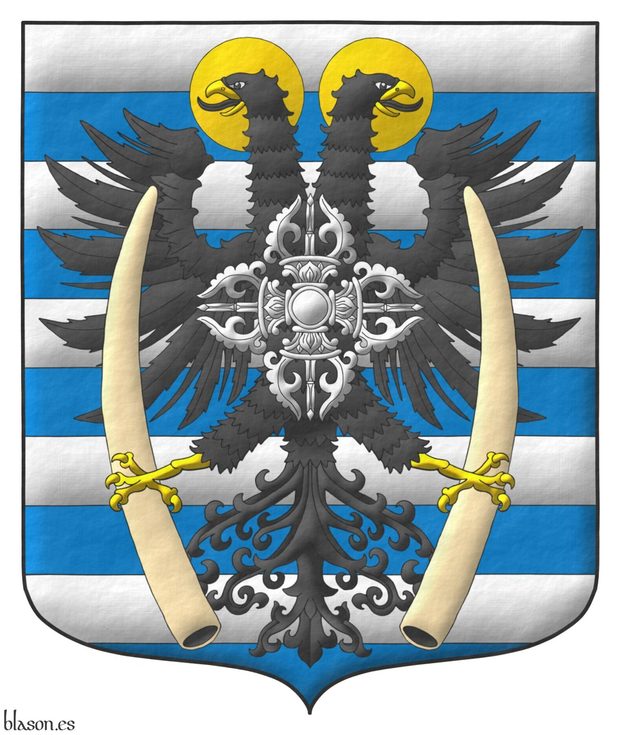
Barry of ten Argent and Azure, overall a double-headed eagle displayed Sable, nimbed, beaked, and membered Or, grasping in each claw an elephant's tusk proper, and charged on its breast with a double vajra Argent.
Escudo fajado de diez piezas de plata y azur, brochante sobre el todo un águila bicéfala de Sable, nimbada, picada y membrada de oro, teniendo en cada garra un colmillo de elefante al natural y su pecho cargado de una vajra doble.
Coat of arms interpreted and emblazoned by me with different shapes and finishings.

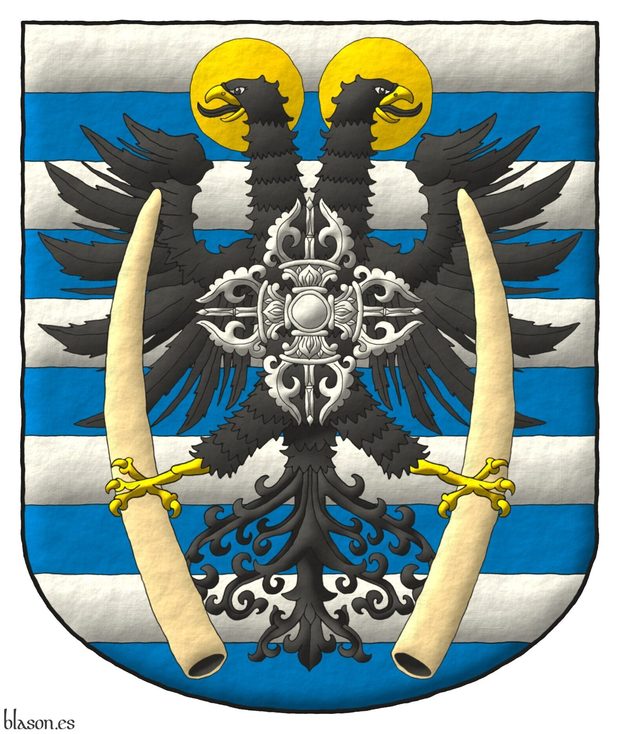
Blazon keywords: Without divisions, Barry, Ten, Argent, Azure, Overall, One, Eagle, Double-headed, Sable, Nimbed, Beaked, Membered, Or, Grasping, Claw, Tusk, Elephant, Proper, Chest, Charged and Double vajra.
Style keywords: Outlined in sable, Illuminated, Freehand, Rough, Rounded, Ogee and Pointed.
Classification: Interpreted and Coat of arms.
Bearer: Rage from Discord.


Robert George Alexander Balchin
Quarterly: 1 and 4 Vert, a crescent within eight mullets in lozenge Or; 2 and 3 Azure, a chain fesswise throughout between three fleurs de lis, 2 and 1, all the links and fleurs de lis per pale Or and Argent; an inescutcheon Azure, bearing a crown of count, charged with an eagle displayed within a bordure Or. Crest: A crown of Baron. Behind the shield the cross of a Knight of Justice of the Most Venerable Order of the Hospital of Saint John of Jerusalem.
Coat of arms emblazoned by me with a pointed shape, illuminated, and with a watercolor finishing.
G0067, Chief Herald of Malta's grant of Robert George Alexander Balchin's arms, whose full achievement has been emblazoned by me for such grant.
Blazon keywords: Quarterly, Vert, One, Crescent, Eight, Mullet, In lozenge, Or, Azure, Chain, Fesswise, Throughout, Between, Three, Fleur de lis, Ordered, Party per pale, Argent, Inescutcheon, Crest and mantling, Crown of Count, Crown, Charged, Eagle, Bordure, Crown of Baron, Behind the shield and Cross.
Style keywords: Outlined in sable, Illuminated, Watercolor and Pointed.
Classification: Personal, Interpreted, Coat of arms and Doctor.
Bearer: Balchin, Robert George Alexander.


Seal of Herbert Leo Buffenbarger
Upon a wreath Argent and Azure, upon a trimount Gules, an eagle wings addorsed and inverted Azure, the head and tail Argent, nimbed Or, grasping a closed book also Or.
The signet ring featuring the crest of the arms of Herbert Leo Buffenbarger, based on his heraldic crest. The crest was designed by his son, John Alan Francis Buffenbarger, and emblazoned by me. The image shows the signet ring featuring the crest upon a wreath, alongside my painting of the crest upon which the ring is based.
Blazon keywords: Crest, Argent, Azure, Gules, Or, One, Three, Upon (wreath), Wreath, Upon, Trimount, Eagle, Wing, Addorsed, Head, Tail, Nimbed, Grasping, Closed book and Book.
Style keywords: Outlined in sable and Illuminated.
Classification: Personal, Interpreted, Boa, Seal, Collage and Photographic.
Bearer: Buffenbarger, Herbert Leo.


Sosa-Garcia, Rodolfo
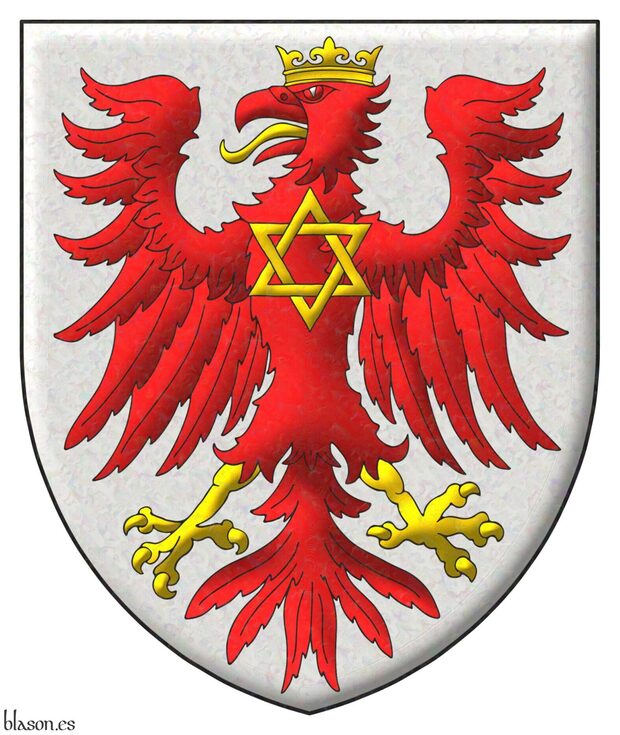
Zurich, Switzerland.
Argent, an eagle displayed Gules, crowned, langued, membered and armed, charged on its chest with a mullet of six points voided, and interlaced Or.
Escudo de plata, un águila de gules, coronada, lampasada, membrada y armada, cargada en su pecho de una estrella de seis puntas, hueca y entrelazada todo de oro.
Illuminated with lights and shadows and with a iridescent finish.
Another version of this blazon «Argent, a eagle displayed Gules, crowned, langued, membered and armed, charged on its chest with a star of David Or».
Blazon keywords: Without divisions, Argent, One, Eagle, Gules, Crowned, Langued, Membered, Armed, Charged, Mullet, Six, Base (lower 1/3), Voided, Interlaced and Or.
Style keywords: Iridescent (nacar), Outlined in sable, Illuminated and Pointed.
Classification: Personal and Created.
Bearer: Sosa-Garcia, Rodolfo.


![Ver [Twelve Lineages of Soria] en enlaces recomendados. Áncora de oro y la divisa enlace.](../css/Ancora.Enlace.png)
Twelve Lineages of Soria
The origin of the Casa Troncal of the Twelve Lineages of Soria dates back to the time of the repopulation of Soria by King Alfonso I of Aragon, although some authors suggest that its origin lies in the time of King Alfonso VII or King Alfonso VIII, the latter being the monarch from whom the well-known privilege of the one hundred suits of armour derives.
My interpretation of the coat of arms of Charles I of Spain and V of the Holy Roman Empire, on the blog Twelve Lineages of Soria in an article entitled Interpretation of the coat of arms of Charles I of Spain and V of the Holy Roman Empire, by the heraldic artist Mr. Antonio Salmerón.
Categories: Link, Holy Roman German Empire, Freehand, Crest and mantling, Imperial crown, Crown, Open royal crown, Fanon, Eagle, Double-headed, Nimbed, Gules, Sable, Or, Argent, Vert and Azure.


Urban VI

202nd Pope of the Church, from 1378 to 1389. «Urbanus VI», named Bartolomeo Prignano, born in Itri, near Naples, in the Lazio region.
Or, an eagle displayed Azure.
Escudo de oro, un águila de azur.
Papal coat of arms interpreted with: a pointed mouth; the field in flat tincture of metal Or; the eagle illuminated in Azure, shaded and outlined in the color of the field; and the whole with a rough finish.
Blazon keywords: Without divisions, Or, One, Eagle and Azure.
Style keywords: Pointed, Illuminated, Outlined in the field tincture, Shaded and Rough.
Classification: Interpreted, Religious and Papal States.
Bearer: Urban VI.


YouTube
Heraldry videos
- Heraldic panther on the arms of the residential neighborhood of Centro, Val'Quirico, Tlaxcala, Mexico.
- Pennon of the residential village of Abundanttia, Val’Quirico, Tlaxcala, Mexico.
- Jean-Christophe Loubet del Bayle's arms.
- Arms of Juan Lanzagorta Vallin.
- How I emblazon the coat of arms of Richard Arthur Brinnhard.
- Coat of arms of Lucas Cruz's family.
- Pennon of Centro, Val’Quirico, Tlaxcala.
- Arms of Jean-Christophe Loubet del Bayle emblazoned by me step by step.
- Standard of Rudolf Juchter van Bergen Quast.
- Coat of arms of Lucas Cruz family designed by him and me and emblazoned by me.
- Coat of arms of Seth Rawson emblazoned by me v.2.
- Coat of Arms of Seth Rawson.
- v.2 Party per chevron: How to blazon and emblazon it, example, Laird Sky's arms.
- v.1 Party per chevron: How to blazon and emblazon it, example, Laird Sky's arms.
- Coat of Arms of Mr. Paul Bengamin Lindsay.
Heraldic channel
My heraldic channel at YouTube is youtube.com/user/ASalmeronTube.
Categories: Technology, Social networks, Cross, Argent, Pomegranate, Bridge, Tower, Escutcheon, Tree, Fish, Bordure, Compony, Eagle, Lion, Pale, Castle, Bell tower, Plough share, Ship, Semé and Fleur de lis.
-
Language
-
Categories of heraldry
-
Divisions of the field
- Without divisions
- Party per pale
- Party per fess
- Party per bend
- Party per bend sinister
- Tierce
- Tierce sinister
- Tierced per pale
- Tierced per fess
- Tierced per bend
- Tierced pallwise inverted
- Quarterly
- Quarterly per saltire
- Gyronny
- Party per fess, the chief per pale
- Party per pale, the sinister per fess
- Party per fess, the base per pale
- Party per pale, the dexter per fess
- Chapé
- Chaussé
- Embrassé
- Contre-embrassé
- Party per chevron
- Enté
- Enté en point
- Flanched
-
Metals
-
Colours
-
Furs
-
Other tinctures
-
Ordinaries and sub-ordinaries
-
Diminutives of the ordinaries
-
Geometric charges
-
Composite ordinaries
-
Inanimate charges from Nature
Atom, Crescent, Diamond, Emerald, Estoile, Increscent, Lightning flash, Moon, Mount, Mullet, Mullet of four points, Orbital, Plough of Ursa Major, Rainbow, Ray of the sun, River, Sea, Snowflake, Sun, Sun in splendour, Sun of May, Trimount and Water.
-
Vegetal charges from Nature
Acorn, Apple, Apple tree, Ash, Bluebonnet, Camellia, Chrysanthemum, Cinquefoil, Cornflower, Dogwood flower, Double rose, Elm, Fleur de lis, Flower, Holm oak, Hop cone, Kapok tree, Laurel, Lily, Linden, Lotus flower, Madonna lily, Oak, Olive tree, Palm tree, Pomegranate, Poplar leaf, Rose, Shamrock, Sunflower, Thistle, Tree, Tulip, Vine and Wheat.
-
Animal charges from Nature
Badger, Bald eagle, Barbel, Barn owl, Bear, Beaver, Beetle, Bighorn sheep, Blackbird, Boar, Brach hound, Bull, Doe, Dog, Dolphin, Dove, Eagle, Elephant, Falcon, Fish, Flame, Fly, Fox, Frog, Goat, Goldfinch, Goose, Heron, Horse, Hummingbird, Jaguar, Lark, Leopard, Lion, Lion passant, Lion rampant guardant, Lioness, Lynx, Male figure, Martlet, Merino ram, Owl, Panther, Parrot, Peacock, Pelican, Pelican in her piety, Puffin, Quetzal, Raven, Roe deer, Rooster, Savage, Seagull, Serpent, She-wolf, Stag, Starling, Talbot, Tyger, Vulture, Warren hound and Wolf.
-
Parts of natural charges
Arm, Beak, Branch, Caboshed, Chest, Claw, Covert, Dorsal fin, Eagle claw, Ermine spot, Escallop, Feather, Foot (palmiped), Foreleg, Forepaw, Hand, Head, Heart, Hoof, Leaf, Neck, Ostrich feather, Palm frond, Paw, Roe deers' attires, Shoulder, Sprig, Stags' attires, Stem, Swallow-tail, Tail, Tail addorsed, Tail fin, Talon, Tooth, Trunk, Trunk (elephant), Two hands clasped, Two wings in vol, Udder, Wheat spike, Wing and Wrist.
-
Artificial charges
Ace of spades, Anchor, Anvil, Arch, Arm vambraced, Armillary sphere, Arrow, Axe, Bell, Bell tower, Beret, Bonfire, Book, Bookmark, Bow, Bridge, Broken, Buckle, Cannon, Cannon dismounted, Cannon port, Canopy roof, Carbuncle, Castle, Celtic Trinity knot, Chain, Chess rooks, Church, Clarion, Clay pot, Closed book, Club, Comb, Compass rose, Conductor's baton, Cord, Covered cup, Crozier, Crucible, Cuffed, Cup, Cyclamor, Dagger, Double vajra, Drum, Ecclesiastical cap, Fanon, Federschwert, Fleam, Four crescents joined millsailwise, Galician granary, Garb, Gauntlet, Geometric solid, Grenade, Halberd, Hammer, Harp, Host, Hourglass, Key, Key ward, Knight, Knot, Lantern, Letter, Line, Loincloth, Menorah, Millrind, Millstone, Millwheel, Monstrance, Mortar, Mullet of six points pierced, Nail, Non-classic artifact, Norman ship, Number, Oar, Oil lamp, Open book, Page, Pair of scales, Parchment, Pestle, Piano, Plough share, Polish winged hussar, Port, Portcullis, Potent, Quill, Ribbon, Rosette of acanthus leaves, Sabre, Sackbut, Sail, Scroll, Scythe, Sheaf of tobacco, Ship, Skirt, Spear, Spear's head, Stairway, Star of David, Step, Sword, Symbol, Tetrahedron, Torch, Tower, Trident, Trumpet, Turret, Two-handed sword, Wagon-wheel, Water-bouget, Wheel, Winnowing fan and With a turret.
-
Immaterial charges
Angel, Archangel, Basilisk, Dragon, Dragon's head, Garuda, Golden fleece, Griffin, Heart enflamed, Mermaid, Our Lady of Mercy, Ouroboros, Paschal lamb, Pegasus, Phoenix, Sacred Heart of Jesus, Saint George, Sea-griffin, Trinity, Triton, Unicorn, Winged hand and Wyvern.
-
External elements
-
Heraldic creations
-
References
-
Formats
-
Keywords on this page
Port and windows, Between, Proper, Pointed, Armed, Azure, Boa, Bordure, Wreath, Charged, Castle, Upon (wreath), Crest, Compony, Ogee, Crown, Created, Quarterly, Triple-towered, Outlined in sable, Displayed, Two, In chief, In base, Coat of arms, Fleur de lis, Personal, Gules, Illuminated, Interpreted, Chief, Langued, Motto, Lion, Masoned, Semi-circular, Or, Party per pale, Leather, Argent, Without divisions, Rampant, Sable, Vert, Grasping, Freehand, Three, One and Eagle.



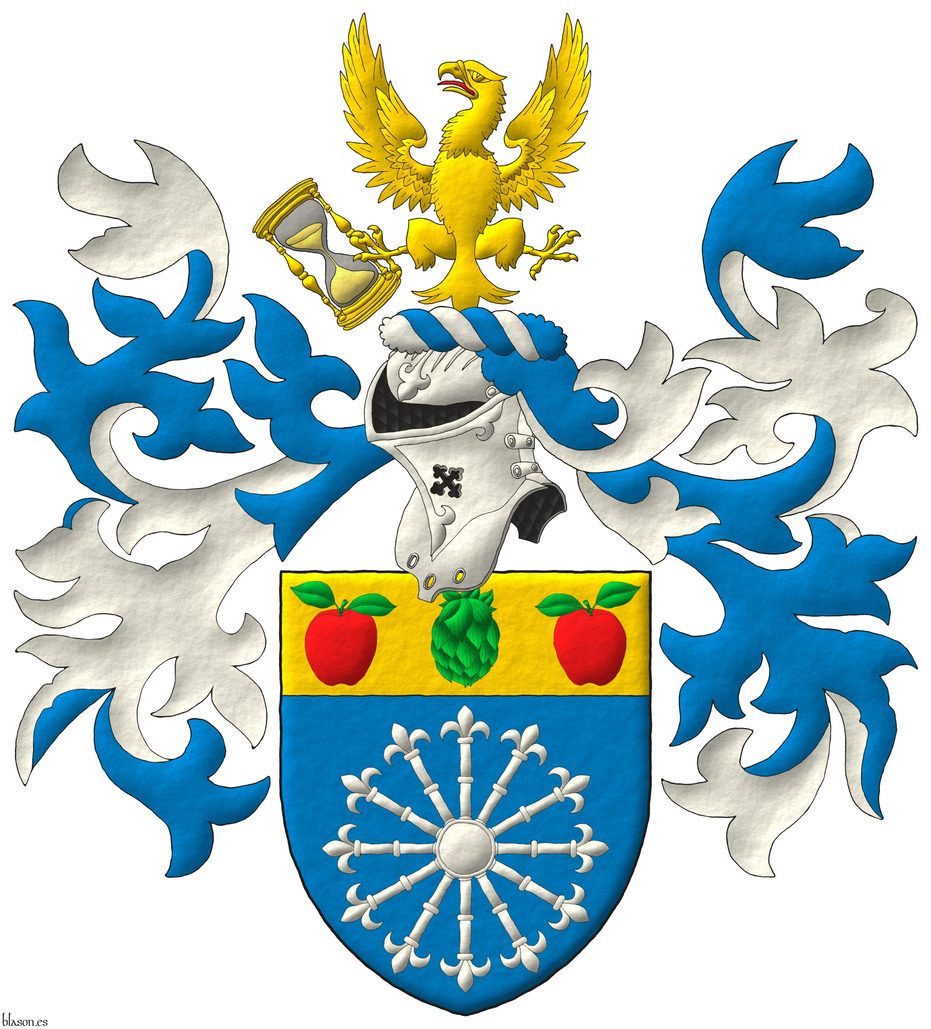
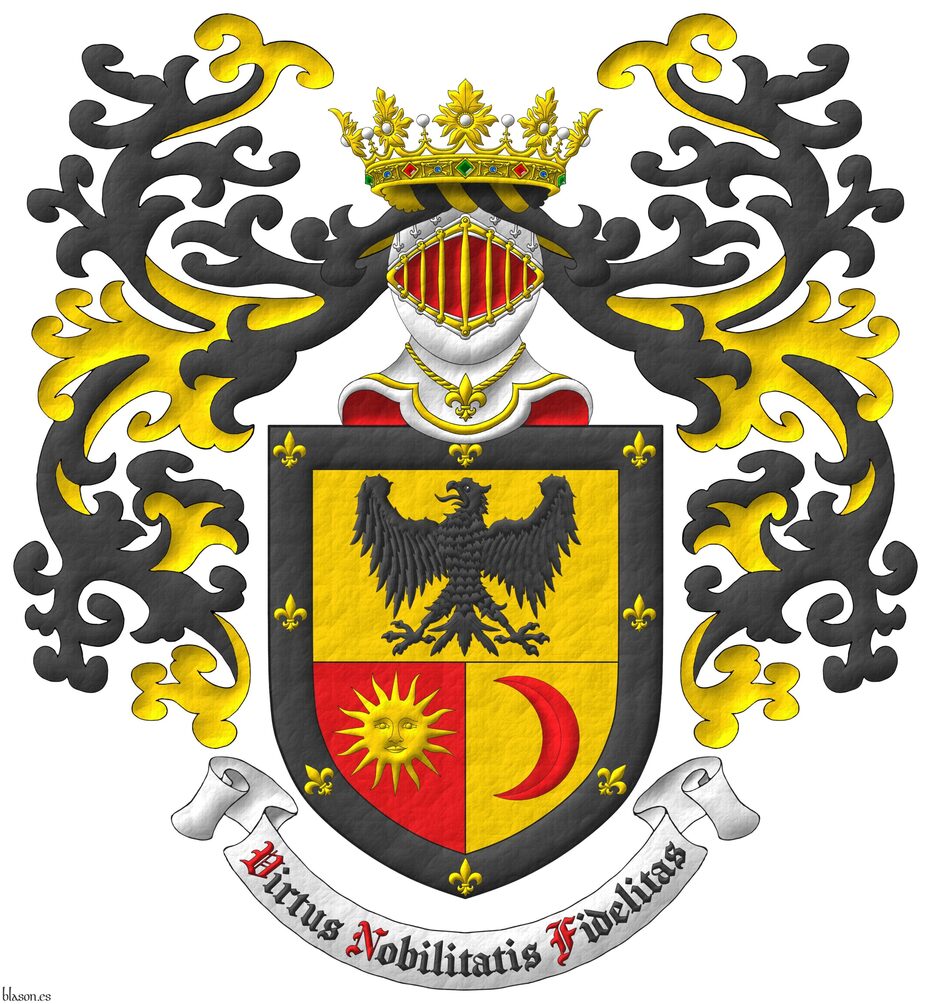
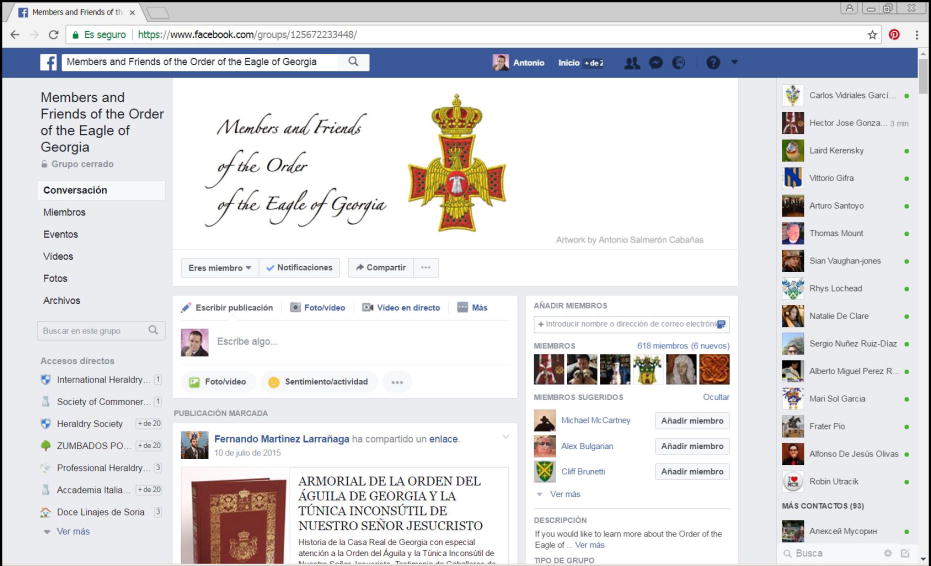


![Juan Lanzagorta Aras accolé with María Dolores Escutia Sánchez [ Party per pale bendy wavy Azure and Or and bendy wavy Azure and Argent, overall three fish naiant in pale Argent ] accolé with [ Or, an eagle displayed bendy Azure and Argent ].](../escudo_armas/LanzagortaArasEscutiaSanchez.18.Acolados.Esquema.1x2.jpg)
